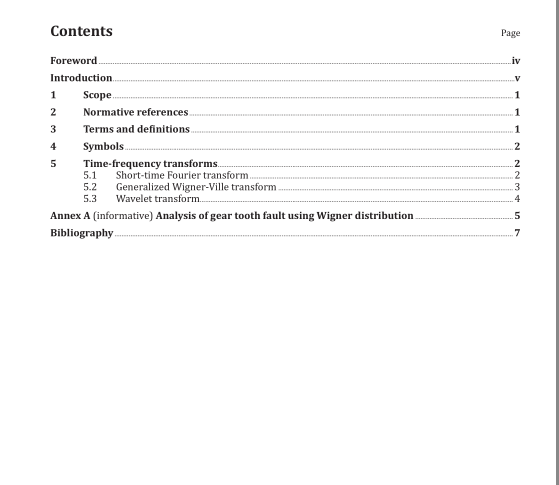ISO 18431-3:2014 pdf download.Mechanical vibration and shock — Signal processing — Part 3: Methods of time-frequency analysis
This part of ISO 18431 specifies methods for the digital calculation of a time-frequency analysis of a given sampled measurement of a physical or engineering quantity, such as acceleration, force, or displacement, over an interval of time. Several mathematical formulations of time-frequency transformations are given with requirements for recording of parameters and recommendations.
The data can be obtained experimentally from measurements of a mechanical structure or obtained from numerical simulation of a mechanical structure. This category of data is very broad because there is a wide variety of mechanical structures, e.g. microscopic instruments, musical instruments,automobiles, manufacturing machines, buildings, and civil structures. The data can determine the response of machines or of humans to mechanical vibration and shock.
2 Normative references
The following documents, in whole or in part, are normatively referenced in this document and are indispensable for its application. For dated references, only the edition cited applies. For undated references, the latest edition of the referenced document (including any amendments) applies.
ISO 2041, Mechanical vibration, shock and condition monitoring — Vocabulary
ISO 18431-1, Mechanical vibration and shock — Signal processing — Part 1: General introduction
3 Terms and definitions
For the purposes of this document, the terms and definitions given in ISO 2041, ISO 18431-1, and the following apply.
3.1 short-time Fourier transform
Fourier-related transform used to determine the time dependence of the sinusoidal frequency and phase content of a time-varying vibration
3.2 Wigner-Ville distribution
quadratic time-frequency description of a vibration based on the autocorrelation of a signal
3.3 generalized Wigner-Ville distribution
time-frequency description of a vibration based on a filtered autocorrelation of a signal
3.4 Choi-Williams transform
generalized Wigner-Ville distribution of a vibration using a specific kernel
3.5 wavelet transform
time-frequency description of a vibration based on the scaled frequency transformation of a signal
4 Symbols
f s = 1/Δt, sampling frequency; the inverse of the sampling period
K number of samples in window w(k)
m index of scaled frequency
N data block length; the number of sampled points that are transformed
n index of time
S x (m,n) short-time Fourier transform of sampled data x(n)
T = NΔt, total time of a block of sampled data
t = nΔt, time
u units of the sampled signal, e.g. displacement or velocity
V(n,m) Cohen class filter for smoothing the Wigner distribution
X(m) discrete Fourier transform of x(n)
5 Time-frequency transforms
5.1 Short-time Fourier transform
The short-time Fourier transform of a signal is the Fourier transform of segments shorter than a given data block. It shows how the spectrum changes with time. It is defined by Formula (1) and detailed in Reference [3].
The following parameters shall be specified: the short-time integration window, K, window function w(k), 0 ≤ k ≤ K − 1, and the increment of the index of time, Δn.
The quantity |S x (m,n)| 2 is plotted for quantitative analysis. The units are u 2 /Hz 2 .
NOTE 1 The increment of the index of time is often 1, K/2, or K.
NOTE 2 The value of K depends on the time and frequency dependence of the signal to be analysed. Larger
values of K show finer frequency details and smaller values of K show finer time details.
5.2 Generalized Wigner-Ville transform
5.2.1 Wigner-Ville transform
The Wigner-Ville time-frequency transform of a signal is defined by Formula (2).
The absolute value of Ω x (m,n) is plotted for quantitative analysis. The units are u 2 s.
NOTE 1 The Wigner-Ville transform is also expressed in terms of the autocorrelation with Formula (3).
NOTE 2 The Wigner distribution is derived from the autocorrelation of the complete data block. This allows greater accuracy in the resolution of time and frequency components, but also generates spurious components in the distribution.
NOTE 3 The sample period of time in the Wigner distribution is twice that of the sample period of the original data x(n) because the time increments of the autocorrelation have twice the period. Therefore, the time corresponding to sample n is t = n2Δt.
NOTE 4 An example of the resolution and spurious components are shown in Annex A.
5.2.2 Choi-Williams transform
The Choi-Williams transform is defined by Formulae (4) and (5).ISO 18431-3 pdf download.ISO 18431-3 pdf download
